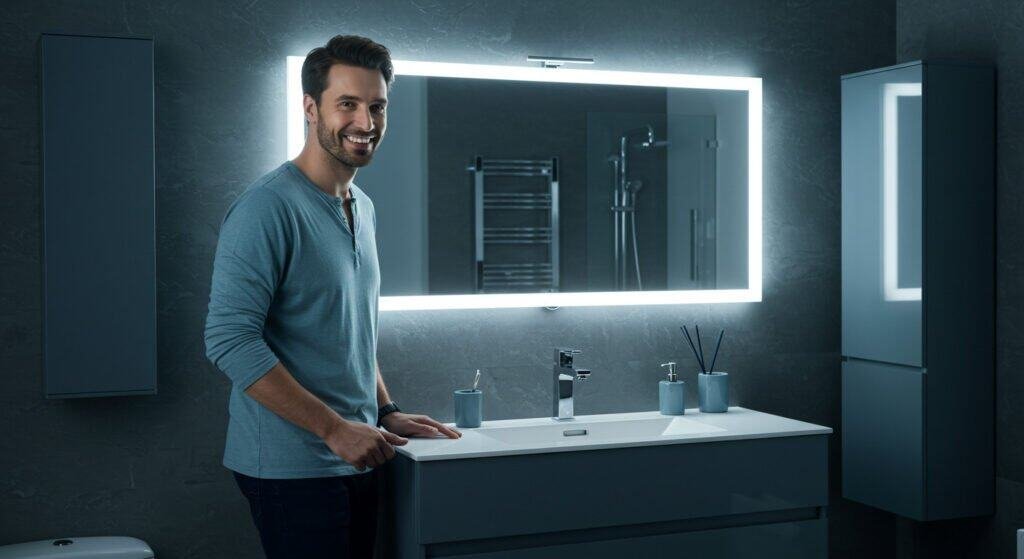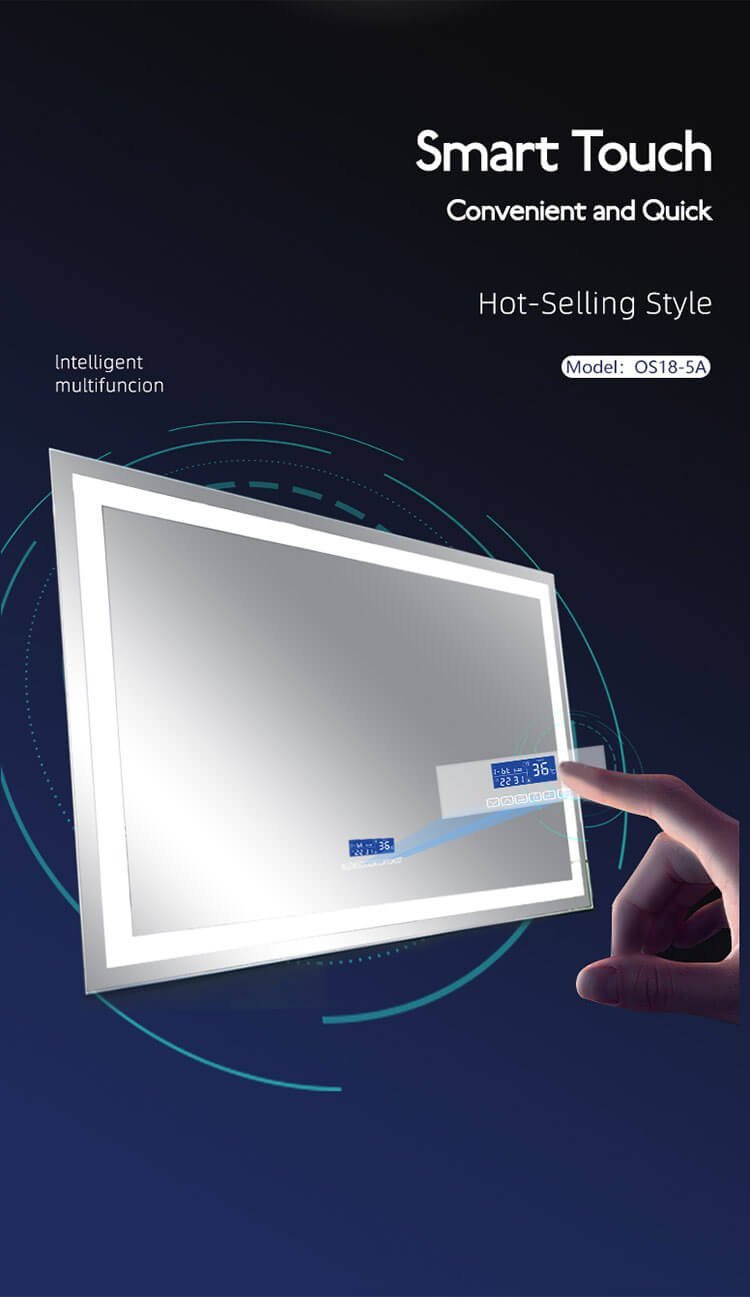How does smart mirror work? This constant device-switching wastes precious time and creates unnecessary frustration during your daily routine. Smart mirror technology solves these problems by combining everything you need into one sleek surface that works like a regular mirror while displaying helpful information.
A smart mirror works by placing a special screen behind a two-way mirror that reflects your image while showing digital content at the same time. The mirror uses sensors to detect when you walk up to it, automatically turning on to display things like the time, weather, and your calendar. It connects to your home WiFi just like your phone does, which allows features like playing music through built-in speakers, clearing fog automatically, and adjusting the lighting brightness to match what you need for different tasks.
Learning how these mirrors actually function helps you decide whether they fit your needs and budget for your home or business bathroom.
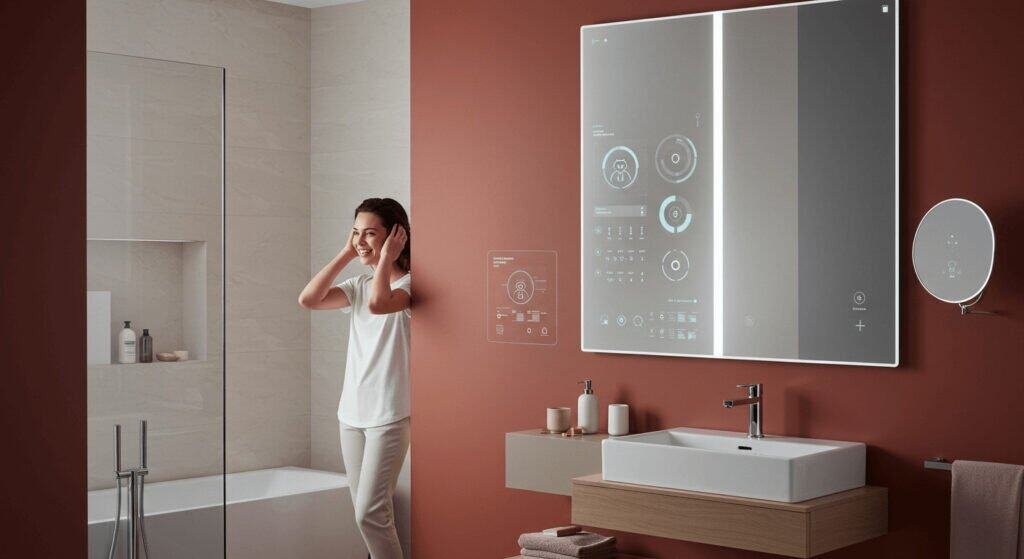
What Is a Smart Mirror?
A smart mirror looks like a normal bathroom mirror but has hidden technology inside that can show you information while you use it. These devices represent the next step beyond traditional mirrors by adding interactive features without losing their core purpose of reflection.
A smart mirror is essentially a regular mirror with a computer screen, lights, and sensors built into it that allow you to see both your reflection and digital information on the same surface. The device combines a partially see-through mirror with LED lights and either an LCD screen or an OLED screen positioned behind the glass.
The main difference between a simple lighted mirror and a true smart mirror comes down to interaction. While basic LED bathroom mirrors just light up your face, smart mirrors can show you customized information feeds. These digital smart mirror systems display weather forecasts, your daily schedule, news headlines, and social media updates. The technology builds on what regular bathroom vanity mirrors and lighted bathroom mirror products already do, then adds layers of helpful features that respond to what you need.
Modern smart mirror projects often work with voice commands, hand gestures, and smartphone apps, creating a smooth experience that traditional mirrors with black frame or rectangular bathroom mirrors simply cannot offer. The magic mirror software running these devices lets you customize everything from simple clock displays to complex data visualization suited for bedrooms, bathrooms, or business spaces like hotels.
What Are the Core Components of a Smart Mirror?
Every smart mirror needs specific parts working together to deliver both mirror reflection and digital features. Understanding these components helps explain how manufacturers create devices that can show information while still working perfectly as mirrors.
The core components of a smart mirror include a two-way mirror panel, an LED display screen, a small computer system, sensors that detect touch or movement, an LED lighting system, a power supply, and wireless connection modules for WiFi and Bluetooth. These parts fit together inside one frame to create a complete device.
The two-way mirror serves as the foundation, using special glass mirror technology that bounces light back to show your reflection while also letting light pass through from behind. Behind this surface, manufacturers place LCD or OLED display panels that create the digital content you see. The small computer processes your commands and runs the software, handling either magic mirror software or the company’s own programs.
Touch screen smart mirror models add touch sensors onto the mirror surface that detect when and where your finger presses, similar to how your smartphone screen works. Movement sensors, usually infrared or ultrasonic types, enable automatic turning on when you walk close enough. The LED lighting system provides both the screen’s backlight and practical vanity lights for seeing yourself clearly. Quality LED mirror products include dimmable LED vanity mirror features with three different light colors and adjustable warmth settings.
Power management circuits control electricity flow, keeping everything safe in humid bathroom environments where bathroom vanity lights and lighted vanity mirrors for bathroom must follow strict safety rules. Wireless modules let the mirror connect to your smartphone and smart home devices, while some advanced models include cameras and microphones for video calls or voice commands, though standard bathroom mirror designs usually skip these for privacy reasons.
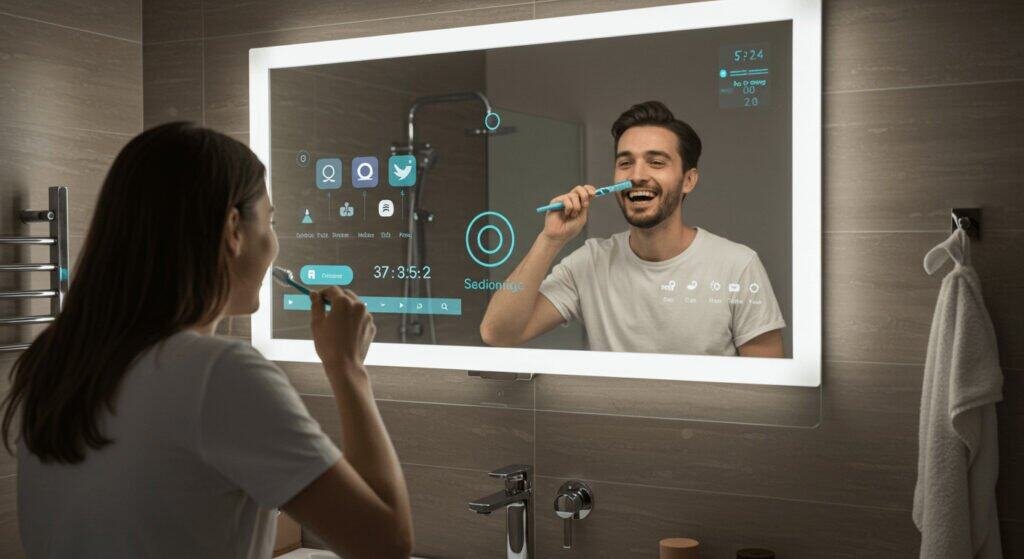
Smart Mirror Comparison Table
| Feature Category | Basic LED Mirror | Mid-Range Smart Mirror | Premium Smart Mirror |
|---|---|---|---|
| Price Range | $100-$300 | $400-$1,200 | $1,500-$3,000+ |
| Core Function | Reflection with LED lighting | Reflection with basic smart features | Full smart integration with advanced features |
| Display Screen | None | Basic information display | High-resolution touchscreen |
| Lighting | Fixed or dimmer LED strips | Adjustable color temperature, dimming | Dynamic lighting zones, circadian rhythm adaptation |
| Anti-fogging | Optional heating pad | Integrated automatic anti-fogging | Rapid anti-fogging with humidity sensors |
| Audio | None | Basic Bluetooth speakers | Premium speakers with noise cancellation |
| Activation Method | Physical switch | Motion sensor or touch button | Multiple methods including voice, gesture, app |
| Connectivity | None | WiFi or Bluetooth | Full smart home integration, WiFi, Bluetooth 5.0 |
| Customization | Limited size options | Moderate size and frame options | Fully customizable size, shape, features |
| Installation | Simple plug-in or direct wire | Professional installation recommended | Professional installation required |
| Warranty | 1-2 years | 3-5 years | 5+ years with extended support |
| Best For | Budget-conscious basic bathroom needs | Modern bathrooms wanting convenience | Luxury residential, business hospitality |
What Smart Functions Can Be Integrated?
Smart mirror features go far beyond basic reflection, adding technologies that address real needs in bathrooms, bedrooms, and business spaces. These capabilities separate premium products from basic bathroom vanity mirrors.
Smart mirrors can include anti-fog systems, Bluetooth music players, time and temperature displays, magnifying sections, motion detection, voice control, weather information, calendar connections, news feeds, and customizable mood lighting. The best smart mirror features combine usefulness with improved daily experience.
Anti-fogging represents one of the most valuable smart mirror features for bathroom use, employing heating elements behind the mirror surface to prevent steam buildup after hot showers. This solves a common frustration with traditional small bathroom mirror products that become useless when steam fills the room. Bluetooth connection lets the LED light mirror vanity work as a bathroom speaker, playing your music or podcasts during your morning routine without needing separate devices.
Time and temperature displays give you quick information exactly when you need it during morning preparations. Magnifying sections help with detailed tasks like applying makeup or shaving, improving what lighted makeup mirror products can do. Motion detection through infrared sensors turns on the display and vanity lights automatically when you approach, then powers down after you leave, saving energy while staying convenient.
Voice control lets you operate everything hands-free, particularly useful when your hands are wet or busy. Some digital smart mirror models show weather forecasts, helping you dress appropriately for outdoor conditions. Calendar connection keeps your appointments visible during daily routines. Customizable LED lighting with three color temperature settings adapts illumination from warm tones good for relaxing to cool daylight tones perfect for precise grooming.
The advantages of smart mirror technology become clear when multiple features work together seamlessly. Modern bathroom mirror installations increasingly demand these integrated capabilities, with smart mirror features and benefits extending to better energy efficiency, reduced clutter from eliminated separate devices, and increased property value. Business applications in hotels and spas particularly benefit from premium smart mirror features that create memorable guest experiences and justify higher room rates.
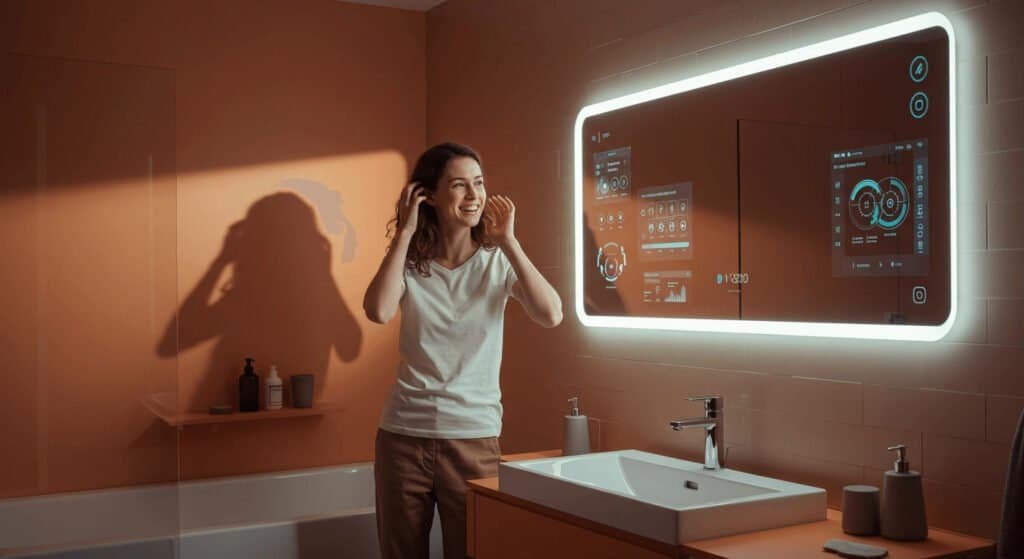
Power Requirements Comparison
| Mirror Type | Typical Wattage | Voltage | Installation Complexity | Annual Energy Cost* |
|---|---|---|---|---|
| Traditional Vanity Mirror with Incandescent Bulbs | 200-400W | 120V AC | Low | $87-$175 |
| Basic LED Bathroom Mirror | 15-30W | 120V AC | Low | $7-$13 |
| LED Mirror with Anti-fogging | 40-60W | 120V AC | Medium | $17-$26 |
| Smart Mirror (Standard Features) | 60-100W | 120V AC | Medium-High | $26-$44 |
| Premium Smart Mirror (All Features Active) | 100-150W | 120V AC | High | $44-$66 |
*Based on 3 hours daily use at $0.13/kWh average electricity rate
Understanding the range from basic bathroom light mirror products through sophisticated smart mirror systems helps buyers select appropriate solutions for their specific situations. The tables above illustrate how features, costs, and requirements scale across product categories, enabling informed decisions that balance functionality against budget and installation constraints.
What to Know About Smart Mirrors?
Potential buyers face numerous considerations when evaluating smart mirror technology for home or business installation. Understanding key specifications and requirements prevents costly mistakes and ensures the mirror performs well long-term.
Before purchasing smart mirrors, buyers should understand installation requirements including electrical specifications, mounting methods, size and weight considerations, water resistance ratings for humidity, warranty coverage, software update capabilities, compatibility with existing smart home systems, and the manufacturer’s technical support quality. These factors significantly impact long-term satisfaction and total ownership cost.
Installation needs vary considerably between LED mirror products and fully integrated smart mirror systems. Basic LED bathroom mirror units typically need only a standard electrical connection, while sophisticated touch screen smart mirror installations may require professional wiring, network connections, and expert mounting to support substantial weight. Bathroom environments require IP44 or higher water protection ratings to ensure safety around moisture and steam, a specification that separates bathroom-appropriate products from smart mirror for bedroom applications.
Size selection must account for both how it looks and how it functions, as modern lighted mirrors for bathrooms need adequate surface area for both reflection and content display without overwhelming the space. Weight becomes important for wall-mounted installations, particularly with large rectangular bathroom mirrors that include heavy display panels and frames, potentially requiring reinforced mounting into wall studs rather than standard drywall anchors.
Software capabilities determine how long features stay relevant, with updateable systems maintaining usefulness as technology evolves, whereas closed systems may become outdated. Smart home compatibility matters for users invested in particular systems, as smooth integration with existing voice assistants and automation platforms increases value.
Warranty coverage reveals manufacturer confidence, with reputable suppliers of bathroom vanity mirrors offering comprehensive protection against defects. Technical support quality becomes essential when troubleshooting connection issues or setting up advanced features. Safety certification marks including UL, CE, or equivalent verify electrical safety and regulatory compliance, protecting both users and contractors from liability.
The smart mirror price reflects these factors, with customizable professional-grade lighted vanity mirrors for bathroom commanding premium pricing compared to consumer products, though the investment pays off through reliability and rich features in demanding business environments.
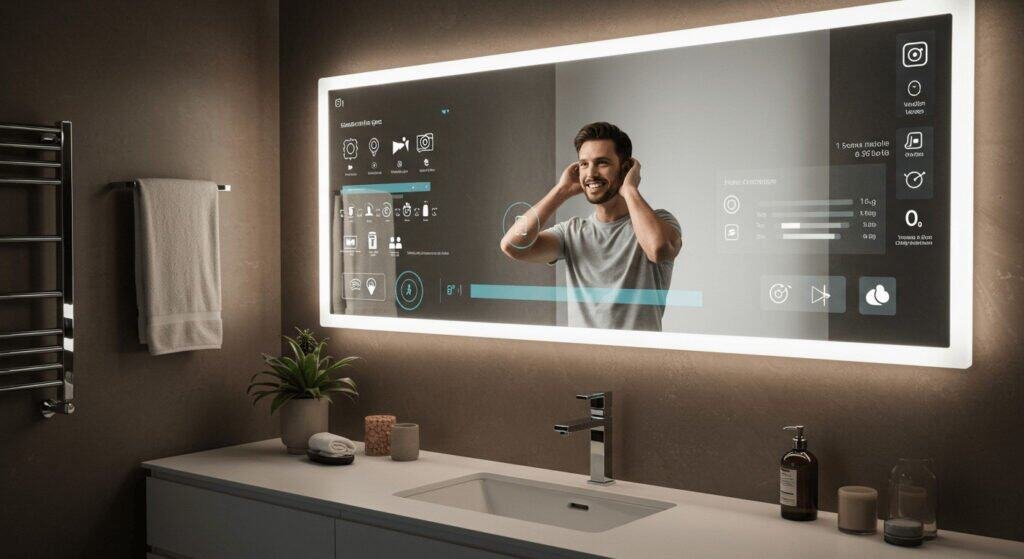
Do Smart Mirrors Have to Be Plugged In?
Power delivery methods significantly affect installation flexibility and appearance, making electrical requirements a primary consideration when planning smart mirror integration into existing or new construction.
Smart mirrors must have electrical power but can receive it through either direct wiring into your building’s electrical system or standard plug-in configurations. Direct wiring connects the mirror permanently to your home’s electricity through a junction box, while plug-in models use regular wall outlets with visible power cords. The choice depends on your situation, local electrical rules, and how you want it to look.
Direct wiring provides the cleanest appearance for wall mirror with lights products by eliminating visible cords, creating a built-in look appropriate for upscale bathrooms and business spaces. This method requires professional electrician services to ensure code compliance and proper safety protection, particularly in wet locations where ground fault circuit interrupter protection is mandatory for bathroom vanity lights and lighted bathroom mirror installations.
The permanent connection simplifies the appearance of backlit mirror designs and handles higher power draws from feature-rich smart mirror systems with multiple LED elements, heating for anti-fogging, and computing components. Plug-in configurations offer installation flexibility, letting homeowners position lighted vanity mirror products wherever convenient outlets exist without electrical modifications. This approach suits rental properties or situations where direct wiring is impractical due to concrete walls or other construction limitations.
However, the visible power cord detracts from the seamless appearance that characterizes premium modern bathroom mirror installations. Some manufacturers offer both options within the same product line, using detachable power cords that can be replaced with direct wire connections during installation. The electrical load varies substantially between basic LED bathroom mirror units drawing twenty to forty watts and sophisticated smart mirror projects consuming one hundred watts or more when all features run simultaneously.
Your home’s electrical circuit must handle these demands alongside other bathroom vanity lights and devices. Battery operation remains impractical for full-featured smart mirrors due to power requirements, though some limited-function lighted makeup mirror products use batteries for portability. Understanding electrical requirements during planning prevents installation surprises and ensures the LED vanity mirror or smart mirror integrates properly into the space while meeting safety standards and appearance goals.
Do LED Mirrors Require Power Supply?
The fundamental electrical needs of LED-illuminated mirrors represent a critical specification that affects installation planning, operating costs, and functionality expectations across all product categories from basic to advanced.
Yes, LED mirrors require a power supply to operate their lighting systems and any integrated smart features. The electrical input powers the LED elements that provide illumination, runs control circuits for features like dimming and color temperature adjustment, and supplies energy to smart components including displays, sensors, and wireless connection modules.
The power requirements for LED mirror products depend on their feature complexity and size. Basic lighted vanity mirrors with simple LED strips typically consume between fifteen and thirty watts, drawing minimal current that standard bathroom circuits easily handle alongside other bathroom vanity lights. More sophisticated bathroom light mirror designs with adjustable color temperature, higher brightness outputs, and extensive LED coverage may draw forty to sixty watts.
Full smart mirror systems including display screens, processors, wireless connectivity, and anti-fogging elements can require eighty to one hundred fifty watts during peak operation. These specifications influence both installation design and operating costs. Modern LED technology provides exceptional energy efficiency compared to old-style incandescent vanity lights, reducing electricity consumption by up to eighty percent while delivering better illumination quality. The LED light mirror vanity achieves this efficiency through solid-state lighting that converts electrical energy directly to light with minimal heat generation.
Voltage requirements typically specify either direct connection to your home’s standard electricity or use low-voltage systems with external transformers that step down power. Low-voltage designs offer enhanced safety for humid bathroom environments, particularly with lighted vanity mirrors for bathroom positioned near water sources. The power supply must match the mirror’s electrical specifications precisely to ensure proper operation and longevity. Quality bathroom vanity mirrors include power management circuits that regulate voltage and current, protecting LED elements from fluctuations that could cause early failure or flickering.
Some advanced lighted bathroom mirror products include power monitoring that tracks energy consumption, aligning with smart home energy management goals. The electrical connection method, whether direct wiring or plug-in, must deliver stable power at the specified voltage and sufficient current capacity for all features. During installation planning, contractors should verify that existing circuits can support the additional load from modern lighted mirrors for bathrooms without overloading breakers, particularly when upgrading from low-wattage traditional mirrors to feature-rich smart mirror installations in older buildings with limited electrical capacity.
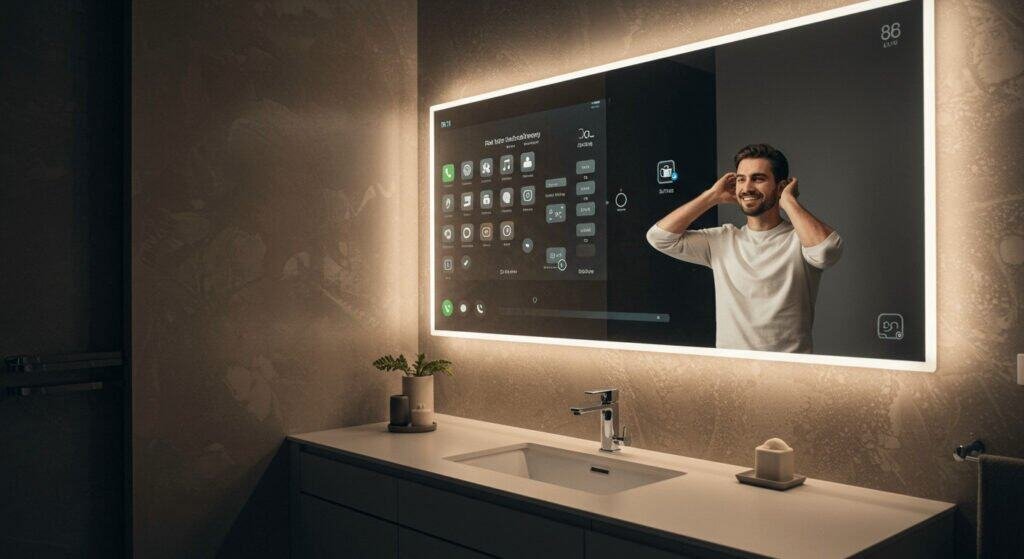
Do I Need Wall Plugs for a Mirror?
Mounting hardware selection directly impacts installation success and long-term stability, with requirements varying based on mirror weight, wall construction, and whether the fixture needs only physical support or must also secure electrical connections.
Wall plugs, also known as wall anchors or mounting anchors, are necessary for mirrors when mounting into drywall or hollow walls that cannot support the mirror’s weight through screws alone. Solid mounting into wood studs or concrete provides adequate support without special anchors, though many installations still use plugs for positioning flexibility independent of stud locations.
The decision depends on mirror weight and wall type. Lightweight small bathroom mirror products weighing under twenty pounds can mount securely using standard plastic expansion anchors rated for appropriate loads. Medium-weight LED bathroom mirror units between twenty and fifty pounds require more robust hardware such as toggle bolts or molly bolts that spread force across larger wall areas, preventing pull-through that would cause the mirror to fall.
Heavy rectangular bathroom mirrors or large lighted vanity mirrors for bathroom exceeding fifty pounds demand installation directly into wall studs whenever possible, using lag screws that go deep into solid wood framing. When stud positioning does not align with where you want the mirror, heavy-duty metal toggle bolts rated for loads exceeding the mirror weight by a factor of three provide necessary safety margins. Wall construction significantly affects anchor selection. Drywall-only mounting requires mechanical anchors that expand behind the wall surface, gripping the back of the material to resist pull-out forces.
Plaster over lath allows different anchor types that key into the solid plaster layer. Tile installations in bathrooms require specialized drill bits and anchors designed for ceramic or porcelain materials, preventing cracks during installation. Concrete or brick walls accept masonry anchors and concrete screws that bite into the dense material. Modern bathroom mirror installation increasingly uses mounting brackets supplied by manufacturers, designed specifically for their products’ weight distribution and attachment points.
These brackets often include features for leveling adjustment and may incorporate hangers similar to picture frame systems that allow the mirror to hook onto wall-mounted rails, simplifying installation while maintaining security. For direct-wired smart mirror or LED mirror products, mounting must also accommodate electrical junction boxes, typically requiring coordination between mirror brackets and box positioning to ensure the mirror conceals the electrical connection while maintaining access for service. Professional installation ensures appropriate anchor selection, proper spacing, and verification that mounting points align with structural supports, particularly crucial for expensive lighted bathroom mirror and smart mirror investments where installation failure could cause catastrophic damage and safety hazards.
How to Activate a Smart Mirror?
User interaction methods determine how intuitively people can access smart mirror features, affecting daily usability and the overall value delivered by the technology investment in home or business settings.
Smart mirrors activate through several methods depending on their design. Motion sensors detect when someone is present and automatically power on the display, touch controls on the mirror surface or frame respond to finger input, voice commands trigger activation through built-in microphones, smartphone apps provide remote control, and some models include physical buttons or switches. Many systems use multiple activation methods for flexibility.
Motion-activated smart mirror products offer the smoothest experience, using passive infrared sensors or ultrasonic detectors to recognize when users approach within a defined range, typically two to four feet. The system instantly powers the display and vanity lights, then automatically turns off after a preset period of inactivity, conserving energy while eliminating the need for manual control. This hands-free operation proves particularly valuable in bathrooms where users often have wet or occupied hands during grooming routines.
Touch screen smart mirror models incorporate sensors that detect finger contact anywhere on predetermined areas of the mirror surface, responding to taps, swipes, and gestures to navigate menus and adjust settings. Some designs integrate physical touch buttons into the frame or lower edge, providing feedback that some users prefer over pure touch-screen interfaces. These buttons typically control essential functions including power, lighting brightness, color temperature adjustment, and feature selection. Voice activation through built-in microphones enables operation via spoken commands, often integrating with popular voice assistants like Amazon Alexa or Google Assistant for natural language interaction.
Users can request information, control smart home devices, or adjust mirror settings without physical contact. Smartphone apps provide comprehensive control and configuration capabilities, connecting to the smart mirror via Bluetooth or WiFi to access advanced settings beyond what simplified mirror interfaces offer. The apps typically allow scheduling, feature customization, software updates, and detailed brightness or color temperature adjustment with precision impossible through simple buttons. Initial setup procedures vary by manufacturer but generally involve powering the mirror through its electrical connection, allowing embedded systems to start up, then following on-screen prompts or app instructions to configure WiFi connectivity, set user preferences, and adjust sensors.
Some lighted vanity mirror products with smart features include physical power switches that must be turned on initially before automatic sensors take over daily operation. Understanding activation methods before purchasing ensures the selected smart mirror aligns with user preferences and bathroom workflow patterns, as motion sensing may not suit all environments while voice control requires appropriate microphone placement and room conditions to function reliably.
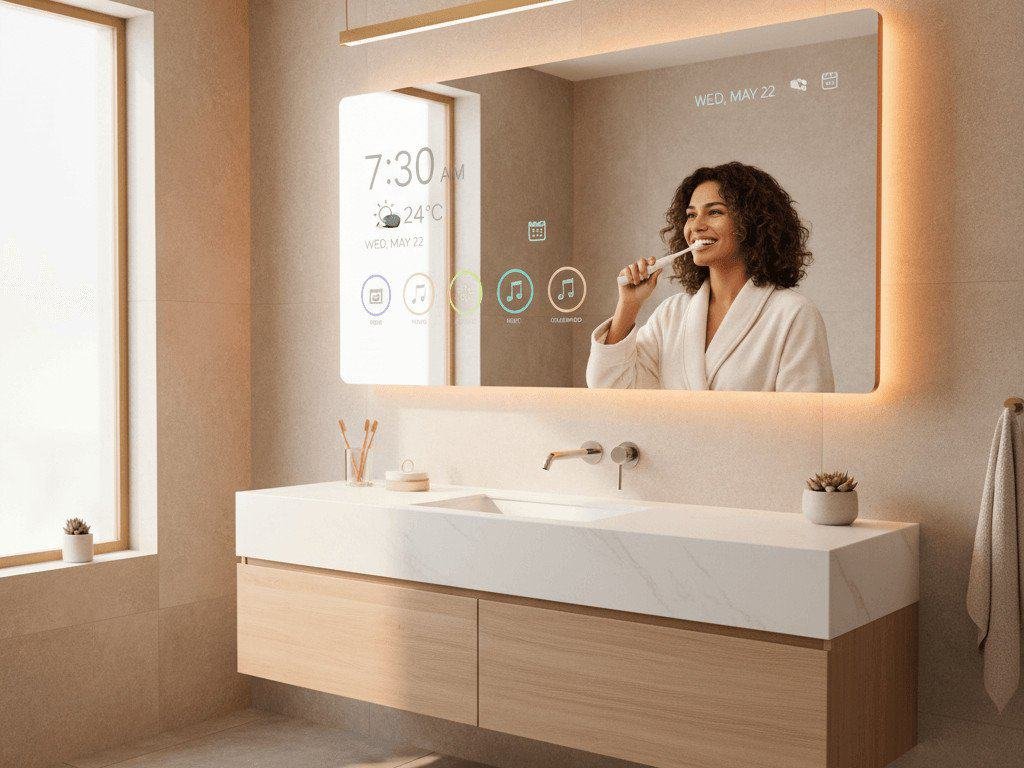
Are Smart Mirrors Worth It?
Investment evaluation requires balancing upfront costs against long-term benefits, considering both practical functionality improvements and quality-of-life enhancements that smart mirror technology delivers compared to traditional alternatives.
Smart mirrors are worth the investment when their integrated features align with user needs and provide sufficient value to justify their higher cost compared to standard bathroom vanity mirrors. The determination depends on factors including budget, desired features, installation context, and whether consolidating multiple devices into one unit delivers meaningful convenience. For many applications, particularly mid-range to luxury home bathrooms and business hospitality settings, the advantages of smart mirror technology outweigh the additional expense.
The financial equation begins with the smart mirror price, which typically ranges from three hundred to three thousand dollars depending on size, features, and quality, compared to one hundred to five hundred dollars for comparable-quality lighted bathroom mirror products without smart capabilities. This premium purchases multiple integrated functions that would otherwise require separate devices and installations.
A typical smart mirror combining high-quality lighting, Bluetooth speakers, anti-fogging, and information display replaces purchases that might include a basic modern bathroom mirror at one hundred fifty dollars, separate vanity lights at one hundred dollars, a waterproof Bluetooth speaker at seventy dollars, and a wall-mounted display at two hundred dollars, totaling five hundred twenty dollars before considering installation costs for multiple items.
The consolidated smart mirror installation requires only one electrical connection and mounting process, reducing labor expenses while delivering a cleaner appearance with no visible separate devices cluttering the bathroom. Energy efficiency represents another financial consideration, as LED mirror technology consumes significantly less electricity than traditional vanity lights while providing better illumination quality and longer lifespan measured in decades rather than years.
The best smart mirror features enhance daily routines through conveniences including automatic anti-fogging that eliminates wait time after showers, hands-free motion activation, and adjustable lighting that improves grooming precision while accommodating different times of day. These quality-of-life improvements have value that transcends pure financial calculations, reducing morning stress and creating more pleasant bathroom experiences.
Property value considerations matter for homeowners and real estate developers, as modern lighted mirrors for bathrooms with smart features serve as attractive amenities during home showings, potentially commanding higher sale prices and appealing to technology-oriented buyers. Business applications in hotels, spas, and luxury apartments benefit from the premium positioning that smart mirror installations enable, justifying higher room rates and creating memorable experiences that encourage positive reviews and repeat business.
However, the investment makes less sense when users need only basic reflection and lighting, have limited budgets, or prefer traditional bathroom mirror appearance. The smart mirror disadvantages including initial cost, potential technical issues, and outdated features as technology evolves weigh more heavily in these contexts. Buyers should assess whether they will actually use integrated features regularly or if simpler lighted vanity mirror products would serve their needs adequately at lower cost.
What Are the Disadvantages of Smart Mirrors?
Objective evaluation requires acknowledging limitations and potential drawbacks alongside benefits, ensuring prospective buyers understand the complete picture before committing to smart mirror technology investments for home or business applications.
Smart mirror disadvantages include higher initial costs compared to traditional mirrors, potential technical issues requiring troubleshooting, dependence on electrical power and network connectivity, complexity that may intimidate less tech-savvy users, limited software update lifecycles leading to outdated features, potential privacy concerns with camera-equipped models, installation challenges requiring professional expertise, and repair difficulties when components fail. These limitations deserve consideration alongside the advantages of smart mirror technology.
The most immediate disadvantage is cost, as the smart mirror price substantially exceeds comparable bathroom vanity mirrors without digital features, potentially straining budgets for home renovations or large business projects outfitting multiple rooms. Technical reliability represents another concern, as smart mirrors include electronic components susceptible to failure from humidity, power surges, or manufacturing defects.
Unlike simple glass mirror products that essentially never fail, smart mirror systems can experience software glitches, connectivity problems, display malfunctions, or sensor failures requiring technical support. Network dependency means features requiring internet connections become unavailable during WiFi outages, limiting functionality to basic lighting and reflection when connectivity fails.
Software becoming outdated threatens long-term value as technology evolves, with today’s cutting-edge smart mirror features potentially becoming outdated or unsupported within five to seven years as manufacturers shift focus to newer products, unlike traditional lighted vanity mirrors for bathroom that remain fully functional for decades. Installation complexity exceeds simple bathroom mirror mounting, often requiring professional electricians and careful coordination of electrical, network, and structural requirements, increasing project costs and limiting do-it-yourself options for handy homeowners.
The learning curve for advanced features may frustrate less technical users who simply want a straightforward lighted bathroom mirror experience without navigating settings menus or troubleshooting connectivity issues. Repair challenges emerge when components fail, as the integrated nature of smart mirror products often requires replacing entire units rather than individual parts, contrasting with modular bathroom vanity lights where a failed bulb or driver can be swapped easily.
Some touch screen smart mirror models prove difficult to clean without triggering unwanted inputs, requiring specific techniques or cleaning modes to disable touch sensitivity during maintenance. The visible display technology, while impressive when active, may create a slightly different reflection quality compared to premium glass mirror products optimized purely for optical clarity, with some users detecting the display layer behind the reflective surface even when powered off.
Weight and size considerations complicate installation, as feature-rich smart mirror systems can exceed one hundred pounds for large sizes, requiring robust wall reinforcement beyond what standard small bathroom mirror mounting demands. These disadvantages do not necessarily invalidate the advantages of smart mirror technology, but they require acknowledgment during decision-making processes, particularly when specifying products for applications where reliability, simplicity, and longevity outweigh cutting-edge features. Selecting established manufacturers with strong technical support, comprehensive warranties, and proven track records in LED bathroom mirror production mitigates many concerns, ensuring investments deliver long-term value despite inherent limitations.
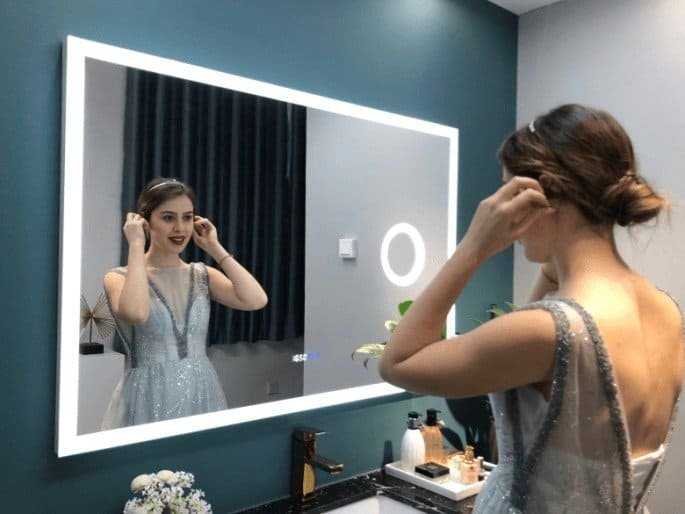
Conclusion
Smart mirror technology transforms ordinary reflective surfaces into intelligent centers that streamline daily routines through integrated lighting, information display, and automated features. Understanding the core components, power requirements, activation methods, and customization possibilities enables informed purchasing decisions that balance functionality against investment, ensuring reliable performance and long-term satisfaction in both home and business applications.
- Clik here to know What Is Copper Free Mirror?
- If you donot know how too choose the right bathroom height click here.
- Know more about LED bathroom mirror Problems
- Clik here to know why Touch Sensor Mirror Not Working
- Clik here to know What Are Standard Vanity Mirror Sizes?
- Clik here to know Why Are Mirrors So Expensive?
- Clik here to know Do LED Mirrors Need Electricity?
- Clik here to know Is a Lighted Mirror Enough Light for a Bathroom?
- Find out 10 Common LED Bathroom Mirror Problems Click Here

